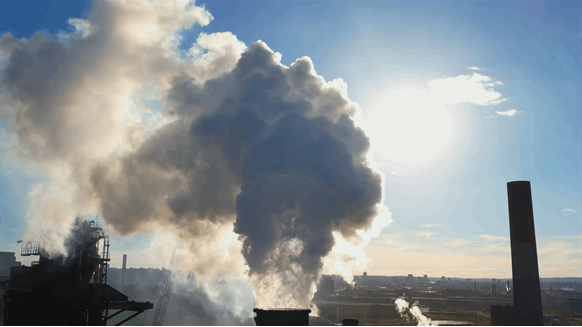The tipping point for carbon dioxide (CO2) emissions from fossil fuels is close, with emissions on track to peak in 2025, according to research and analysis by Rystad Energy.
On the current global path of announced policies, projects, industry trends and expected technological advances, global CO2 emissions are on track to reach around 39 gigatonnes per year (Gtpa) in 2025 before settling at a steady annual decline as industries clean up their carbon footprint.
Emissions hit a record high in 2022 as countries scrambled to secure reliable and affordable fuel for power generation in the wake of Russia’s invasion of Ukraine. As a result, many turned to more carbon-intensive fuels as a short-term solution to their energy security crises, revitalizing coal plants and prioritizing gas over cleaner alternatives. While these fuels will still have a role to play in the global economy for decades to come, the broader push toward a cleaner future shows no signs of slowing.
As a sign of things to come, direct emissions of CO2 (carbon dioxide from the burning of fossil fuels in plants around the world) from power and heat generation will peak this year. The fall will be minimal initially before picking up momentum in the coming years, becoming a major factor in the decline in total CO2 emissions from all sectors by 2025.
“Peaking fossil fuel CO2 emissions in the next two years is an outstanding global achievement, outstanding given the current supply chain bottlenecks and heightened focus on energy security. If the industry can maintain this momentum, global warming of less than 2.0 degrees Celsius is within reach,” said Artem Abramov, head of clean technology research at Rystad Energy.
Fossil CO2 emissions hit a record high of around 38.3 Gtpa last year, raising doubts and questions about the world’s ability to meet ambitious climate targets to limit warming to between 1.5 and 2 .0 degrees Celsius. However, Rystad’s comprehensive emissions model points to an imminent emissions tipping point. The data shows a peak of 39 Gtpa in 2025, but that timeline could increase into next year if the near-term macroeconomic outlook accelerates the energy transition.
Energy and heating drive emissions reductions worldwide
Last year was a challenge for global climate goals. On the one hand, a record amount of utility-scale solar and wind capacity was added, about 300 GW globally, leading to a considerable increase in electricity generated from renewable sources, a trend that is likely to return to increase this year.
However, these new installations were weaker than expected, thanks to low-carbon supply chain disruptions and inflationary pressure. In addition, the war in Ukraine fundamentally disrupted energy flows, resulting in widespread natural gas shortages, particularly in Europe, facilitating the increased use of coal for power generation. As a result, direct fossil CO2 emissions from the power and heat sectors reached record highs of around 14.4 Gtpa.
Global industrial emissions last year remained stable at around 9.95 Gtpa as the post-Covid recovery in China was offset by a visible decrease in Chinese industrial carbon intensity.
Transport emissions increased by 0.2 Gtpa to reach 7.8 Gtpa in 2022, down from pre-Covid peaks of 8.2 Gtpa due to continued weakness in the aviation sector, caused by the pandemic and the acceleration of the penetration of electric vehicles. The adoption of electric vehicles is approaching the levels needed to offset the overall annual growth in the size of the active car fleet.
Despite these setbacks, the electricity and heating sector is expected to drive the next decline in fossil CO2 from mid-decade onwards. By 2023, the addition of renewable generation capacity is expected to exceed the increase in electricity demand. Starting in 2025, annual additions of renewable generation will begin to materially affect total fossil fuel production.
This trend will also accompany the ongoing shift from coal to gas. Emissions from transport and industry will peak at the end of this decade, but are also expected to join the decarbonisation trend in the second half of the 2020s. At the same time, first-generation of large-scale commercial carbon capture initiatives will also begin to play a non-negligible role, driven initially by projects in Europe and North America.
Europe, US and China progressed, India’s emissions grow
The decarbonisation picture differs between regions and the main contributors to emissions are expected to play divergent roles in the coming years. For example, Europe, the US and China are on track to reduce fossil CO2 emissions by 24%, 18% and 10% respectively by 2030. Europe and the US are on track to structurally decarbonise their economies, leaning towards newly implemented clean technology and low carbon policies from 2025 onwards.
China’s transport sector is electrifying at a rapid rate, domestic renewable installations are strong, as is its low-carbon supply chain, and it is positioned for accelerated industrial decarbonisation of intensive sectors energy in the next five to ten years. . As a result, we expect Chinese fossil CO2 emissions to flatten this year to around 12.5 Gtpa before declining between 2026 and 2028.
At the other end of the spectrum, India is expected to continue its drive to expand CO2 emissions as its economy expands and population grows. We expect India’s CO2 emissions to increase by 36% between 2022 and 2030, overtaking Europe in 2025 and the US in the early 2030s. We expect rising emissions to slow in the 2030s as coal-free power generation is increasing to meet incremental growth in electricity demand.
Elsewhere, industrial emissions are expected to rise by around 20% by 2030, driven mainly by other Asian countries, except for China, which will account for half of the increase in total fossil fuel emissions growth .
To contact the author, send an email to bojan.lepic@rigzone.com


